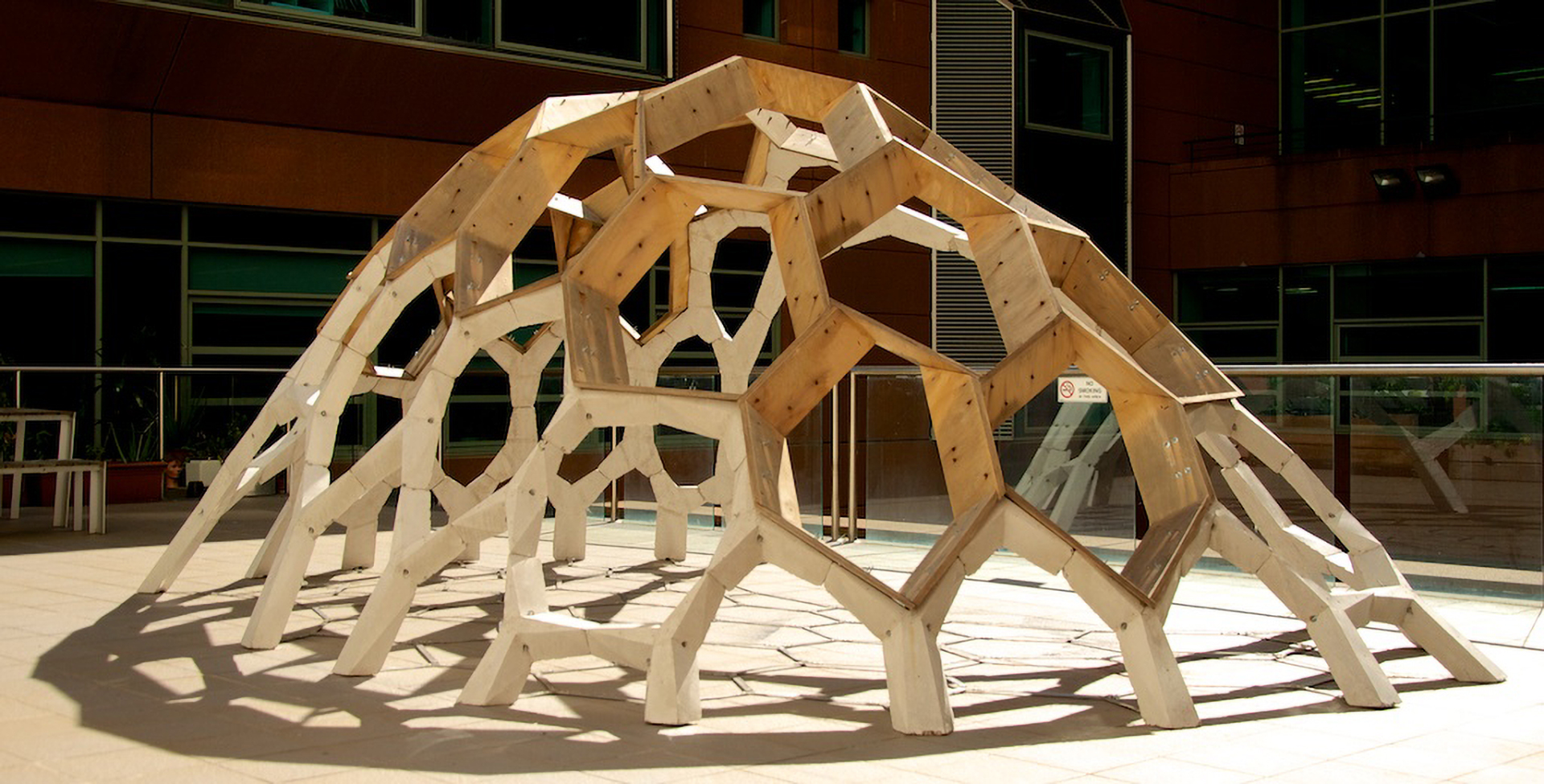iT Innovation in Timber
| INNOVATION IN TIMBER |
|---|
| PROJECTS |
SUPER SUCCAH FRANKSTON STATION UTZON/40 HOBART MICRO-ICONS SUPERWOOD |
|---|---|
| AWARDS | SUPER SUCCAH AUSTRALIAN TIMBER DESIGN AWARDS 2020 [NATIONAL] STANDALONE STRUCTURE MERIT AWARD [TOP 4] - AUSTRALIAN TIMBER DESIGN AWARDS 2020 [NATIONAL] SMALL BUDGET MERIT AWARD [TOP 3] FRANKSTON STATION RUNNER-UP INTERNATIONAL DESIGN COMPETITION HOBART MICRO-ICONS WINNER SMARTER HOBART CHALLENGE INTERNATIONAL DESIGN COMPETITION - WINNER NATIONAL AWARD FOR PLANNING EXCELLENCE, TECHNOLOGY + DIGITAL INNOVATION |

Innovation in Timber
New Material Practices and Technologies
iT
Low embodied-carbon, renewable and healthy, timber may be the key construction material of the future.
Of all the primary building materials, timber is arguably the most conducive to the adoption of digital practices. Within our work, we explore the concept of digital timber across all design and construction work stages: form-finding and generation, analysis and optimisation; file-to-factory CNC and robotic protocols; prefabrication strategies; and on-site assembly and validation enabled via augmented-reality.
Our goal is to not only demonstrate timber’s increasing importance in meeting the challenges of climate change but to further embed the architectural project within highly specific material and labour networks. These ecologies both leverage and empower communities through the realisation of new skill-based economies. Two projects that best demonstrate this aspiration are Hobart Micro-Icons and our renewal scheme for the Frankston Train Station. Each, draws upon their cultural and material hinterland, manifesting them into a strong architectural language of timber.
Our goal is to not only demonstrate timber’s increasing importance in meeting the challenges of climate change but to further embed the architectural project within highly specific material and labour networks. These ecologies both leverage and empower communities through the realisation of new skill-based economies. Two projects that best demonstrate this aspiration are Hobart Micro-Icons and our renewal scheme for the Frankston Train Station. Each, draws upon their cultural and material hinterland, manifesting them into a strong architectural language of timber.
TImber Gridshell
Our design for the new Frankston train station deployed glue-laminated Victorian Ash — grown locally and fabricated by XLam in Woodonga — to realise a structurally efficient and beautiful doubly-curved timber gridshell.
Our design for the new Frankston train station deployed glue-laminated Victorian Ash — grown locally and fabricated by XLam in Woodonga — to realise a structurally efficient and beautiful doubly-curved timber gridshell.

Reciprocal Plywood Gridshell
The Utzon/40 Pavilion deploys an innovative
quasi-reciprocal gridshell that allows for local structural performance to be tuned in negotiation with solar and visual transparancy aims.
The Utzon/40 Pavilion deploys an innovative
quasi-reciprocal gridshell that allows for local structural performance to be tuned in negotiation with solar and visual transparancy aims.

Prefabricated Hardwood CLTP
The Hobart Micro-Icons project uses digtially fabricated Tasmanian Cross-Laminated Plantation Hardwood to realise a mass-customised system for public infrastructure.
The Hobart Micro-Icons project uses digtially fabricated Tasmanian Cross-Laminated Plantation Hardwood to realise a mass-customised system for public infrastructure.
Curved Plywood
Bending-active pleated form allows the extremely plywood to be self-supporting without the need for a secondary structure.
Tmber-only finger and dowel joints eliminare the economic and environmental cost of high embodied-carbon steel fixings.
Project Team:
Minh Triet Tran
Kien Phuoc [Kent] Ngo
Ngoc Khanh Pham
Khaled Dababneh
Bending-active pleated form allows the extremely plywood to be self-supporting without the need for a secondary structure.
Tmber-only finger and dowel joints eliminare the economic and environmental cost of high embodied-carbon steel fixings.
Project Team:
Minh Triet Tran
Kien Phuoc [Kent] Ngo
Ngoc Khanh Pham
Khaled Dababneh


45x90mm Spaceframe
Fast-growing Radiata Pine is the most-used plantation timber in Australia. Here it is deployed towards the production of a non-uniform large-span spaceframe optimised for solar and structural performance.
Tmber-only connections inspired by Japanese joinery techniques are realised through digital fabricationa and eliminare the need for steel fixings.
Project Team:
Mitchell Moxley
Rita Aziz
Yin Teng [Janet] Chin
Scarlett Rogers
Fast-growing Radiata Pine is the most-used plantation timber in Australia. Here it is deployed towards the production of a non-uniform large-span spaceframe optimised for solar and structural performance.
Tmber-only connections inspired by Japanese joinery techniques are realised through digital fabricationa and eliminare the need for steel fixings.
Project Team:
Mitchell Moxley
Rita Aziz
Yin Teng [Janet] Chin
Scarlett Rogers


Minimally Processed Timber Logs
A series of Blue- and Grey-Gum forks were selected from a forrest in north-east NSW and then scanned to form a catalogue of available elements.
Evolutionary optimisation and a digital springs model was then used to find the best configuration of banches from the catalogue. Natural forks end up as waste in conventional timber harvesting, thier usage here achieves strong grain alignment and therefore high structural performance.
Project Team:
Ling Kit [Jackie] Cheung
Rui Hang [Ray] Yong
Michael Anthony [Mic] Kindica
Xueying [Summer] Wang
A series of Blue- and Grey-Gum forks were selected from a forrest in north-east NSW and then scanned to form a catalogue of available elements.
Evolutionary optimisation and a digital springs model was then used to find the best configuration of banches from the catalogue. Natural forks end up as waste in conventional timber harvesting, thier usage here achieves strong grain alignment and therefore high structural performance.
Project Team:
Ling Kit [Jackie] Cheung
Rui Hang [Ray] Yong
Michael Anthony [Mic] Kindica
Xueying [Summer] Wang



